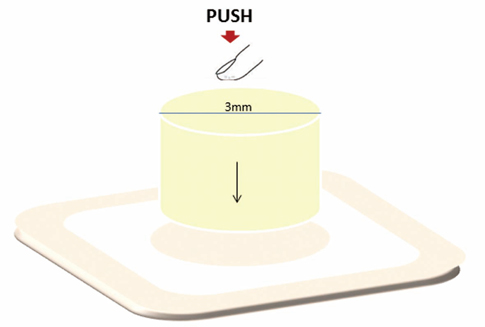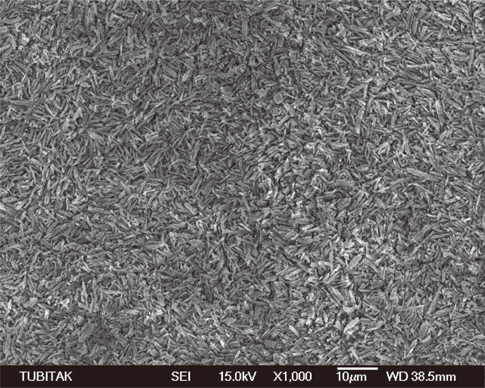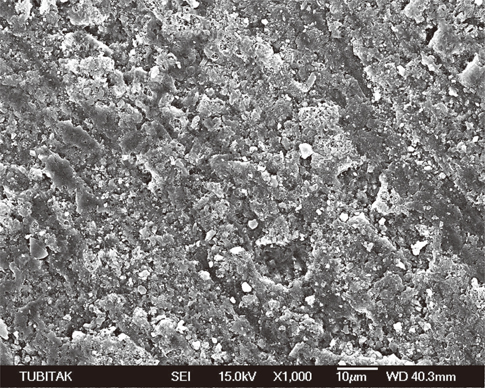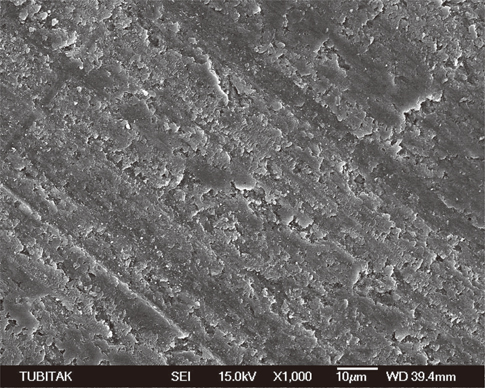J Adv Prosthodont.
2013 May;5(2):98-103. 10.4047/jap.2013.5.2.98.
Shear bond strength of resin cement to an acid etched and a laser irradiated ceramic surface
- Affiliations
-
- 1Department of Prosthodontics, Faculty of Dentistry, Yeditepe University, Istanbul, Turkey. pinar.kursoglu@gmail.com
- 2Department of Restorative Dentistry, Faculty of Dentistry, Yeditepe University, Istanbul, Turkey.
- KMID: 2284747
- DOI: http://doi.org/10.4047/jap.2013.5.2.98
Abstract
- PURPOSE
To evaluate the effects of hydrofluoric acid etching and Er,Cr:YSGG laser irradiation on the shear bond strength of resin cement to lithium disilicate ceramic.
MATERIALS AND METHODS
Fifty-five ceramic blocks (5 mm x 5 mm x 2 mm) were fabricated and embedded in acrylic resin. Their surfaces were finished with 1000-grit silicon carbide paper. The blocks were assigned to five groups: 1) 9.5% hydrofluoric-acid etching for 60 s; 2-4), 1.5-, 2.5-, and 6-W Er,Cr:YSGG laser applications for 60 seconds, respectively; and 5) no treatment (control). One specimen from each group was examined using scanning electron microscopy. Ceramic primer (Rely X ceramic primer) and adhesive (Adper Single Bond) were applied to the ceramic surfaces, followed by resin cement to bond the composite cylinders, and light curing. Bonded specimens were stored in distilled water at 37degrees C for 24 hours. Shear bond strengths were determined by a universal testing machine at 1 mm/min crosshead speed. Data were analyzed using Kruskal-Wallis and Mann-Whitney U-tests (alpha=0.05).
RESULTS
Adhesion was significantly stronger in Group 2 (3.88 +/- 1.94 MPa) and Group 3 (3.65 +/- 1.87 MPa) than in Control group (1.95 +/- 1.06 MPa), in which bonding values were lowest (P<.01). No significant difference was observed between Group 4 (3.59 +/- 1.19 MPa) and Control group. Shear bond strength was highest in Group 1 (8.42 +/- 1.86 MPa; P<.01).
CONCLUSION
Er,Cr:YSGG laser irradiation at 1.5 and 2.5 W increased shear bond strengths between ceramic and resin cement compared with untreated ceramic surfaces. Irradiation at 6 W may not be an efficient ceramic surface treatment technique.
Keyword
MeSH Terms
Figure
Cited by 1 articles
-
Effect of surface treatments on the bond strength of indirect resin composite to resin matrix ceramics
Ersan Çelik, Sezgi Cinel Şahin, Doğu Ömür Dede
J Adv Prosthodont. 2019;11(4):223-231. doi: 10.4047/jap.2019.11.4.223.
Reference
-
1. McLaughlin G. Porcelain veneers. Dent Clin North Am. 1998; 42:653–656.2. Blatz MB. Long-term clinical success of all-ceramic posterior restorations. Quintessence Int. 2002; 33:415–426.3. Jensen ME, Sheth JJ, Tolliver D. Etched-porcelain resin-bonded full-veneer crowns:in vitro fracture resistance. Compendium. 1989; 10:336–338. 340–341. 344–347.4. Bergman MA. The clinical performance of ceramic inlays: a review. Aust Dent J. 1999; 44:157–168.5. Hayashi M, Wilson NH, Yeung CA, Worthington HV. Systematic review of ceramic inlays. Clin Oral Investig. 2003; 7:8–19.6. Krämer N, Frankenberger R. Clinical performance of bonded leucite-reinforced glass ceramic inlays and onlays after eight years. Dent Mater. 2005; 21:262–271.7. Sjögren G, Molin M, van Dijken JW. A 5-year clinical evaluation of ceramic inlays (Cerec) cemented with a dual-cured or chemically cured resin composite luting agent. Acta Odontol Scand. 1998; 56:263–267.8. Braga RR, Ballester RY, Daronch M. Influence of time and adhesive system on the extrusion shear strength between feldspathic porcelain and bovine dentin. Dent Mater. 2000; 16:303–310.9. Davidson CL. Luting cement, the stronghold or the weak Link in ceramic restoration? Adv Eng Mater. 2001; 3:763–767.10. Kelly JR, Giordano R, Pober R, Cima MJ. Fracture surface analysis of dental ceramics: clinically failed restorations. Int J Prosthodont. 1990; 3:430–440.11. Thompson JY, Anusavice KJ, Naman A, Morris HF. Fracture surface characterization of clinically failed all-ceramic crowns. J Dent Res. 1994; 73:1824–1832.12. Haselton DR, Diaz-Arnold AM, Dunne JT Jr. Shear bond strengths of 2 intraoral porcelain repair systems to porcelain or metal substrates. J Prosthet Dent. 2001; 86:526–531.13. Chen JH, Matsumura H, Atsuta M. Effect of etchant, etching period, and silane priming on bond strength to porcelain of composite resin. Oper Dent. 1998; 23:250–257.14. Chen JH, Matsumura H, Atsuta M. Effect of different etching periods on the bond strength of a composite resin to a machinable porcelain. J Dent. 1998; 26:53–58.15. Sorensen JA, Engelman MJ, Torres TJ, Avera SP. Shear bond strength of composite resin to porcelain. Int J Prosthodont. 1991; 4:17–23.16. Wolf DM, Powers JM, O'Keefe KL. Bond strength of composite to porcelain treated with new porcelain repair agents. Dent Mater. 1992; 8:158–161.17. Bailey LF, Bennett RJ. DICOR surface treatments for enhanced bonding. J Dent Res. 1988; 67:925–931.18. Ferrando JM, Graser GN, Tallents RH, Jarvis RH. Tensile strength and microleakage of porcelain repair materials. J Prosthet Dent. 1983; 50:44–50.19. Jochen DG, Caputo AA. Composite resin repair of porcelain denture teeth. J Prosthet Dent. 1977; 38:673–679.20. Semmelman JO, Kulp PR. Silane bonding porcelain teeth to acrylic. J Am Dent Assoc. 1968; 76:69–73.21. Lacy AM, LaLuz J, Watanabe LG, Dellinges M. Effect of porcelain surface treatment on the bond to composite. J Prosthet Dent. 1988; 60:288–291.22. Calamia JR. Etched porcelain veneers: the current state of the art. Quintessence Int. 1985; 16:5–12.23. Spohr AM, Sobrinho LC, Consani S, Sinhoreti MA, Knowles JC. Influence of surface conditions and silane agent on the bond of resin to IPS Empress 2 ceramic. Int J Prosthodont. 2003; 16:277–282.24. Stangel I, Nathanson D, Hsu CS. Shear strength of the composite bond to etched porcelain. J Dent Res. 1987; 66:1460–1465.25. Matinlinna JP, Vallittu PK. Bonding of resin composites to etchable ceramic surfaces - an insight review of the chemical aspects on surface conditioning. J Oral Rehabil. 2007; 34:622–630.26. Ozcan M, Alkumru HN, Gemalmaz D. The effect of surface treatment on the shear bond strength of luting cement to a glass-infiltrated alumina ceramic. Int J Prosthodont. 2001; 14:335–339.27. Bertolini JC. Hydrofluoric acid: a review of toxicity. J Emerg Med. 1992; 10:163–168.28. Ersu B, Yuzugullu B, Ruya Yazici A, Canay S. Surface roughness and bond strengths of glass-infiltrated alumina-ceramics prepared using various surface treatments. J Dent. 2009; 37:848–856.29. Gökçe B, Ozpinar B, Dündar M, Cömlekoglu E, Sen BH, Güngör MA. Bond strengths of all-ceramics: acid vs laser etching. Oper Dent. 2007; 32:173–178.30. Akova T, Yoldas O, Toroglu MS, Uysal H. Porcelain surface treatment by laser for bracket-porcelain bonding. Am J Orthod Dentofacial Orthop. 2005; 128:630–637.31. Spohr AM, Borges GA, Júnior LH, Mota EG, Oshima HM. Surface modification of In-Ceram Zirconia ceramic by Nd:YAG laser, Rocatec system, or aluminum oxide sandblasting and its bond strength to a resin cement. Photomed Laser Surg. 2008; 26:203–208.32. Cavalcanti AN, Pilecki P, Foxton RM, Watson TF, Oliveira MT, Gianinni M, Marchi GM. Evaluation of the surface roughness and morphologic features of Y-TZP ceramics after different surface treatments. Photomed Laser Surg. 2009; 27:473–479.33. Jacobsen NL, Mitchell DL, Johnson DL, Holt RA. Lased and sandblasted denture base surface preparations affecting resilient liner bonding. J Prosthet Dent. 1997; 78:153–158.34. da Silva Ferreira S, Hanashiro FS, de Souza-Zaroni WC, Turbino ML, Youssef MN. Influence of aluminum oxide sandblasting associated with Nd:YAG or Er:YAG lasers on shear bond strength of a feldspathic ceramic to resin cements. Photomed Laser Surg. 2010; 28:471–475.35. Kimyai S, Mohammadi N, Navimipour EJ, Rikhtegaran S. Comparison of the effect of three mechanical surface treatments on the repair bond strength of a laboratory composite. Photomed Laser Surg. 2010; 28:S25–S30.36. Chen JR, Oka K, Kawano T, Goto T, Ichikawa T. Carbon dioxide laser application enhances the effect of silane primer on the shear bond strength between porcelain and composite resin. Dent Mater J. 2010; 29:731–737.37. Hossain M, Nakamura Y, Yamada Y, Suzuki N, Murakami Y, Matsumoto K. Analysis of surface roughness of enamel and dentin after Er,Cr:YSGG laser irradiation. J Clin Laser Med Surg. 2001; 19:297–303.38. Usumez A, Aykent F. Bond strengths of porcelain laminate veneers to tooth surfaces prepared with acid and Er,Cr: YSGG laser etching. J Prosthet Dent. 2003; 90:24–30.39. Güler AU, Yilmaz F, Ural C, Güler E. Evaluation of 24-hour shear bond strength of resin composite to porcelain according to surface treatment. Int J Prosthodont. 2005; 18:156–160.40. Fabianelli A, Pollington S, Papacchini F, Goracci C, Cantoro A, Ferrari M, van Noort R. The effect of different surface treatments on bond strength between leucite reinforced feldspathic ceramic and composite resin. J Dent. 2010; 38:39–43.41. Aida M, Hayakawa T, Mizukawa K. Adhesion of composite to porcelain with various surface conditions. J Prosthet Dent. 1995; 73:464–470.42. Gökçe B. Effects of Er:YAG laser irradiation on dental hard tissues and all-ceramic materials: SEM Evaluation. In : Kazmiruk Viacheslav, editor. Scanning Electron Microscopy. New York: In tech;2012. p. 179–212.43. Shiu P, De Souza-Zaroni WC, Eduardo Cde P, Youssef MN. Effect of feldspathic ceramic surface treatments on bond strength to resin cement. Photomed Laser Surg. 2007; 25:291–296.44. Akyil MS, Yilmaz A, Karaalioğlu OF, Duymuş ZY. Shear bond strength of repair composite resin to an acid-etched and a laser-irradiated feldspathic ceramic surface. Photomed Laser Surg. 2010; 28:539–545.45. Eversole LR, Rizoiu I, Kimmel AI. Pulpal response to cavity preparation by an erbium, chromium:YSGG laser-powered hydrokinetic system. J Am Dent Assoc. 1997; 128:1099–1106.46. Kursoglu P, Yurdaguven H, Kazazoglu E, Çalýkkocaoglu S, Gursoy T. Effect of Er,Cr:YSGG laser on ceramic surface. Balk J Stomatol. 2006; 10:103–109.47. Ozcan M, Allahbeickaraghi A, Dündar M. Possible hazardous effects of hydrofluoric acid and recommendations for treatment approach: a review. Clin Oral Investig. 2012; 16:15–23.
- Full Text Links
- Actions
-
Cited
- CITED
-
- Close
- Share
- Similar articles
-
- Effects of hydrofluoric acid concentration and etching time on the shear bond strength between lithium disilicate ceramic and resin cement
- Effect of etching time on shear bond strength of resin cements to reinforced all-ceramic crowns
- The shear bond strength of two adhesives bonded to composite resin and glass ionomer cement restorations
- A study on the shear bond strength of light-cured glass ionomer cement
- A shear bond strength of resin cements bonded to pressable porcelain with various surface treatments








